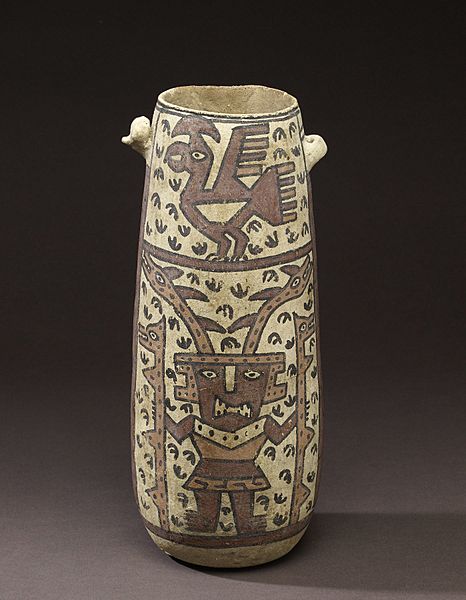Archivo: Chancay - Vessel - Walters 20092035

Descripción: The Chancay art style dominated Peru's Central Coast during the Late Intermediate Period, although there was no centralized, overarching state authority ruling the region. Textiles and pottery were the primary artistic media, the former being among the most colorful, visually complex, and technically excellent weavings ever produced in Peru. Chancay pottery, on the other hand, is often rather casually or carelessly painted, its slip characterized by a matte surface finish and a palette restricted to white and black (with the infrequent addition of red or beige). The low-fired Chancay ceramics make them susceptible to surface damage, unlike the earlier pottery of the Moche, Nasca, and Waricultures. On the other hand, Chancay painting can be as lively as that of any Andean tradition. The acute difference in quality between Chancay ceramics and textiles reflects sociopolitical divisions in Chancay culture. Burial patterns indicate that the painted ceramics were consumed by all levels of Chancay society, whereas fine textiles and precious metal objects were restricted to members of higher status. As elsewhere in the Andean world, artistic quality and materials conveyed messages of hierarchy and power. This tall, narrow vessel features the frontal rendering of a male figure. He grasps a puma-headed staff in each hand, and two serpent-headed rays emanate from his head. These pan-Andean features link the figure to traditional depictions of supernatural beings or deities and shamans. The bird painted at the top of the vessel reflects this theme in its crescent-shaped head adornment, which distinguishes the "Sicán Deity" or "Sicán Lord," who may be a culture hero or a deity among cultures to the north. The "Sicán Lord" is associated primarily with the Sicán and later Chimú societies of the North Coast, although the Chimú extended their influence over the Chancay people at the end of the Late Intermediate Period. It is not improbable that this symbol of divinity and/or sacred ancestry was adopted by the Chancay. The painter of this tall vessel animated the scene by filling the background with black avian footprints, which, at the least, lend motion to the bird if not implying its ritual performance.
Título: Vessel
Créditos: Museo Walters: Home page Info about artwork
Autor(a): Anónimo (Chancay)Unknown author
Permiso: Esta obra es libre y puede ser utilizada por cualquiera para cualquier propósito. Si usted desea utilizar este contenido fuera de Wikimedia, no necesitará pedir permiso mientras sigua las condiciones de la licencia explicitadas en esta página. Wikimedia ha recibido un correo electrónico que confirma que el titular de los derechos de autor ha aprobado la publicación y la reutilización de la obra bajo las condiciones que se mencionan en esta página. La correspondencia ha sido revisada por un miembro de OTRS y ha sido guardada en nuestro sistema. El texto de la correspondencia está disponible solo para voluntarios confiables bajo el Ticket #2012021710000834. Enlace al permiso: https://ticket.wikimedia.org/otrs/index.pl?Action=AgentTicketZoom&TicketNumber=2012021710000834 Find other files from the same ticket:
Términos de Uso: Dominio Público
Licencia: Dominio Público
¿Se exige la atribución?: No
Usos del archivo
La siguiente página enlaza a este archivo:

